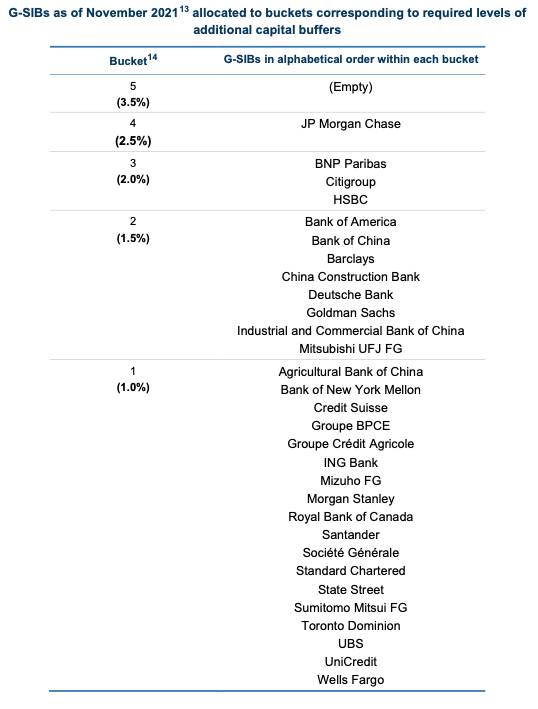The Financial Stability Board (FSB) today published the 2021 list of global systemically important banks (G-SIBs) using end-2020 data and an assessment methodology designed by the Basel Committee on Banking Supervision (BCBS).

The 30 banks on the list remain the same as the 2020 list.
FSB member authorities apply the following requirements to G-SIBs:
- Higher capital buffer: The G-SIBs are allocated to buckets corresponding to higher capital buffers that they are required to hold by national authorities in accordance with international standards. Compared with the 2020 list, three banks have moved to a higher bucket: JP Morgan Chase has moved from bucket 3 to bucket 4, BNP Paribas has moved from bucket 2 to bucket 3 and Goldman Sachs has moved from bucket 1 to bucket 2.
- Total Loss-Absorbing Capacity (TLAC): G-SIBs are required to meet the TLAC standard, alongside the regulatory capital requirements set out in the Basel III framework. The TLAC standard began being phased in from 1 January 2019 for G-SIBs identified in the 2015 list that continued to be designated as G-SIBs.
- Resolvability: These include group-wide resolution planning and regular resolvability assessments. The resolvability of each G-SIB is also reviewed in a high-level FSB Resolvability Assessment Process (RAP) by senior regulators within the firms’ Crisis Management Groups.
- Higher supervisory expectations: These include supervisory expectations for risk management functions, risk data aggregation capabilities, risk governance and internal controls.
The BCBS today published updated denominators used to calculate banks’ scores; the thresholdsused to allocate the banks to buckets; and the values of the twelve high-level indicators of all banks in the main sample used in the G-SIB scoring exercise. The BCBS also provides the links to the public disclosures of all banks in the full sample of banks assessed.
Earlier this month, the BCBS approved a technical amendment to the G-SIB assessment methodology review process, which replaces the previous three-year review cycle with a process of ongoing monitoring and review.
In the near term, the BCBS will review the implications of developments related to the European Banking Union for the G-SIB methodology. In particular, this will include a targeted review of the treatment of cross-border exposures within the Banking Union on the G-SIB methodology.
A new list of G-SIBs will next be published in November 2022.

